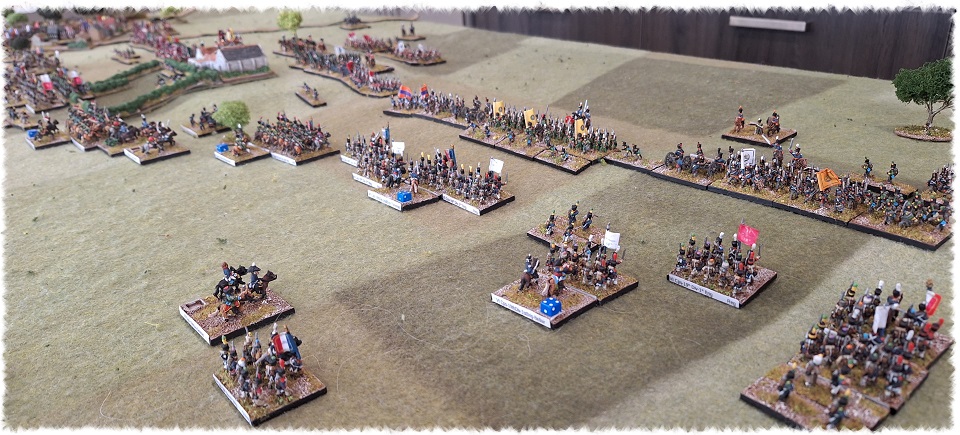
Hello and welcome to the first post covering a playtest of my own rule set “On to Glory”. In this article, I’ll only be covering the first few game turns with future posts planned as the game progresses. Here I hope to balance an AAR with a look at the rule mechanics I’ve put together so far. I’ll try my best to concentrate on the action and not waffle on too much about the rules at this stage.
As it stands, I’m pretty happy with what I’ve managed to come up with so far. Although I am enjoying the process I know my limitations and can’t see these rules leaving the safety of my war room.
Please feel free to send me any questions, comments or feedback.
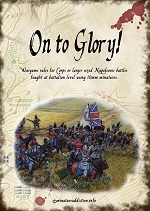
First, a few basics.
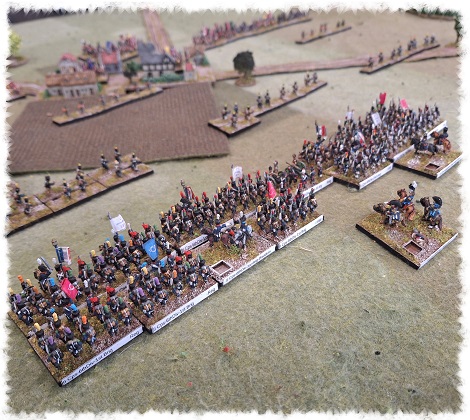
The premise of “On to Glory” is aimed at corps to army-sized games. In this system, single elements (stands) represent a battalion, cavalry regiment or artillery battery. For example, pictured to the left is Jerome’s (1815) infantry division. The seven battalions of Baron Bauduin’s first brigade can be seen in the foreground. Jerome’s command stand sits just back from the division’s artillery battery. On the far side of the artillery is Soye’s brigade.
All stands have a common frontage of 40mm which is also the basic unit of measurement in the game (MU). This along with opposing combat dice rolls and pip dice for movement will be familiar to anyone who has played systems derived from the DBM/A/N family of games.
This game was played on a six-by-four-foot table with 10mm figures. Set in 1815, a short article on how I generated the table layout can be found here.
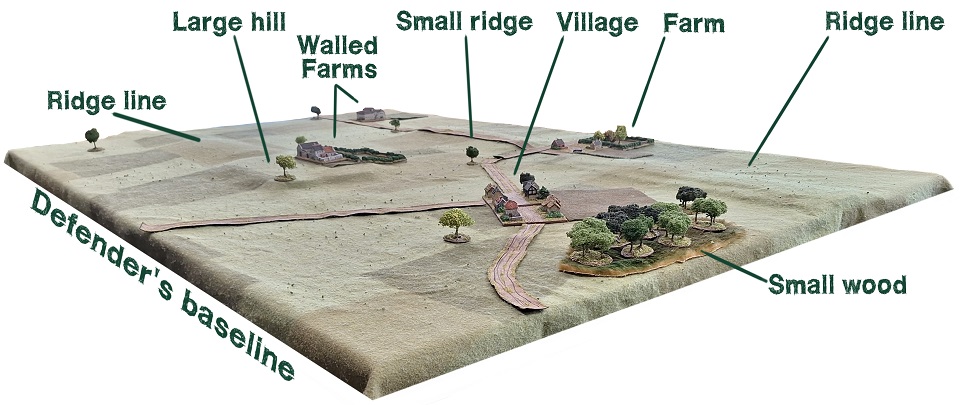
British (defending) deployment:
- A. Perponcher’s 2nd Netherlands infantry division: Bijlandt and Saxe-Weimar’s infantry brigades stand ready on the reverse slope of a small ridge line. Their artillery sits astride the ridge line’s crest while his skirmishers hold the low ground.
- B. Alten’s 3rd infantry division: The British 5th brigade holds the area around the walled farm on the large hill. Kielmmansegge’s Hanoverians bridge the gap between the British and Dutch troops. Best’s 4th Hanoverians sit behind these two brigades.
- C. The Prince of Orange (army commander): Sits next to Alten behind the farm.
- D. Trip’s heavy cavalry (independent) brigade: Only the command stand is on the table as they are currently held in reserve.
- E. Olfermann’s Brunswick division: Also in reserve so only the command stand is visible.
- F. Piction’s 5th division holds the right. Kempt’s boys and two batteries are tasked with holding the flat ground between the village and the farm on the hill. Pack’s 9th brigade is stationed in and around the village with a brigade of Hanoverians placed between the village and the woods.
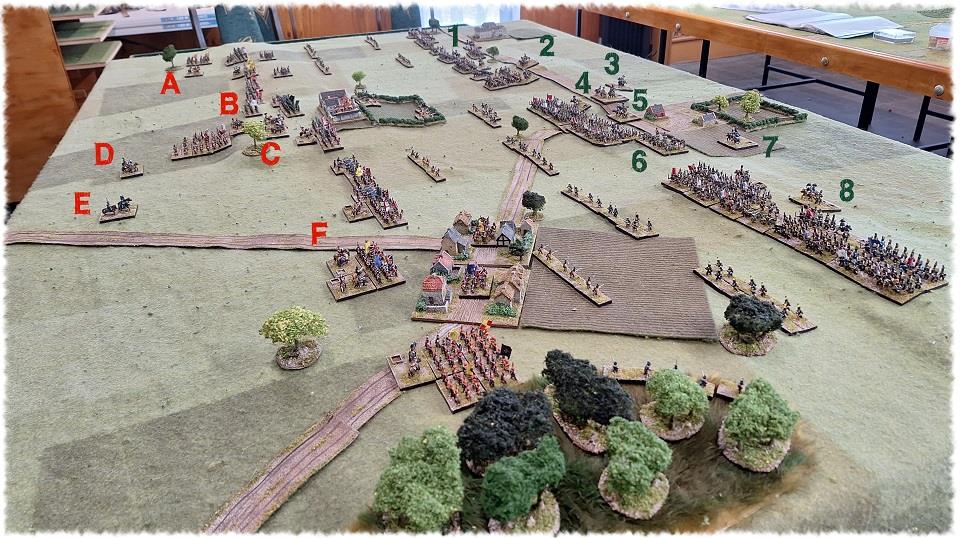
French (attacking) deployment/plan:
- 1. Bachelu’s infantry division: Together with Pire’s light cavalry division will engage the British left and centre with pinning attacks only.
- 2. Pire’s four light cavalry regiments accompanied by a battery of horse guns.
- 3. Kellerman’s Heavy cavalry division sits in reserve. Only the divisional command stand is on the table.
- 4. Foy’s infantry division supported by the Corps heavy artillery will attack the open ground between the large hill and the village.
- 5. Reille’s (army) command stand.
- 6. Foy’s divisional artillery together with the corps 12pdrs form a sixteen-gun battery on a low ridge line to the left of the brigade.
- 7. Simmer’s 19th infantry division starts the game in reserve so only its command stand is on the table.
- 8. Jerome’s large division is tasked with taking the village.
BUA: Built-up areas:
Built-up areas play an important part in OtG. To win the game the French must break the British army. If they fail to do so by the end of turn ten the British player (defender) wins the game. However, by capturing any BUA sector in the defender’s half of the battlefield the French will gain more time to complete their victory conditions (1 turn for open BUA’s and 2 turns for walled sectors). Hence Jerome’s orders to storm the village and thereby gain two extra game turns. Once lost, sectors can be recaptured by the British removing any time gained by the French.
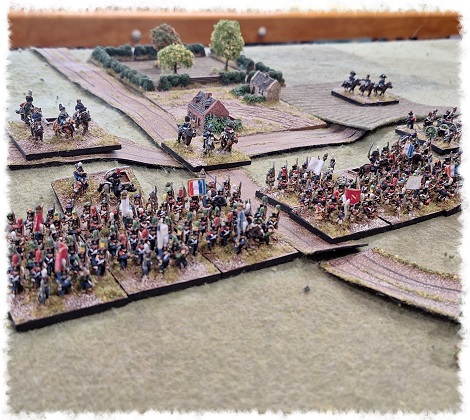
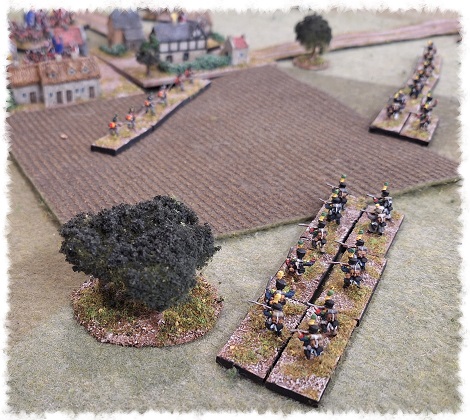

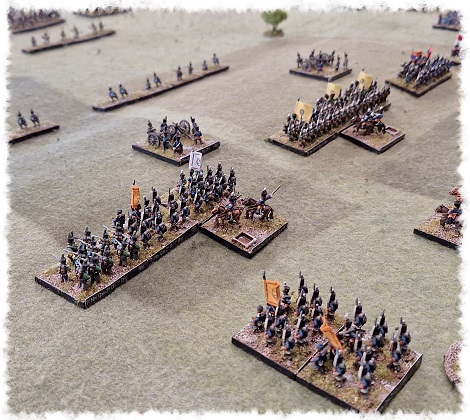
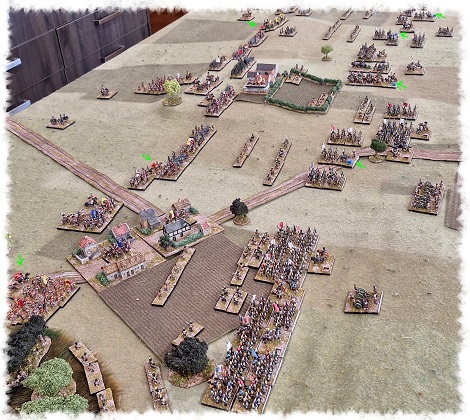
Turn 1:
The whole French army advanced towards the British lines. Both players score hits with their artillery batteries in the bombardment phase. The little green arrows highlight these disorder markers in the accompanying photo. I use small dice to record “degree of disorder points” (DDPs) on each command stand. Red for the British and blue for the French.
Stationed on the open plain and facing a sixteen-gun battery Kempt’s men got the worst of it. One of his battalions even giving ground under the weight of the fire.
Bachelu’s, Pire’s and Foy’s advancing formations did not escape the attention of the Allied gunners either.
At the bottom of the (above) picture, you can see some Hanoverian Skirmishers have moved into the small wood.
Turn Sequence:
Starting with the attacker each player takes it in turn to complete the following four-phase sequence. Command-Movement-Firing and Melee.
Command phase:
- Generate command points for all Independent brigades, divisional and army command stands. Roll 1D6 for each stand with independent brigades dividing their result by two.
- Transfer command points from reserve formations to the commander.
- Issue command points (0rders) from the C-in-C to divisional and independent brigade commanders.
- Assign command points to brigades within each division.
- Each brigade may roll one rally dice for each command point it has been assigned.
2. Movement phase:
- Each brigade may use the command points it has been issued to make a single element or group movement.
3. Firing phase:
- Players roll opposing dice to decide the outcomes of musketry and artillery bombardments. The phasing player picks the order in which these combats are resolved.
- Make any outcome moves.
4. Melee:
- Players roll opposing dice to decide the outcomes of melee combat. The phasing player picks the order in which these melees are fought.
- Make any outcome moves.
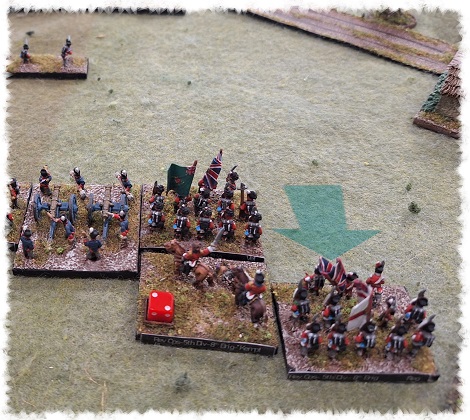
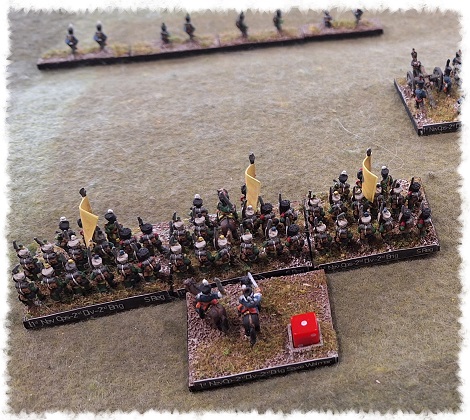
Turn 2:
Jerome’s 2nd Brigade launches an attack on the village. Four battalions go forward in two assault columns. The first of which is supported by the fire from the divisional artillery. This turned out to be very fortunate for them in the combat roll results below.
- First combat:
- British veteran battalion (4)+1D6 (6)= 10
- French regular battalion (3)+assault column (1)+artillery support(1)+1D6(1)=6
- Beaten, but not doubled (destroyed). The first column gives ground and the brigade commander receives 1DDP (degree of disorder point)
“Go the 92nd”
- Second combat:
- British veteran battalion (4)+1D6(4)=8
- French regular battalion (3)+assault column(1)+1D6(1)=5
- Beaten again, but not doubled. The column gives ground and Soye takes another DDP.
There are no bonuses for defending a BUA, but the attacker must double the defender to drive them out. The loser of each combat takes a DDP (brigade).
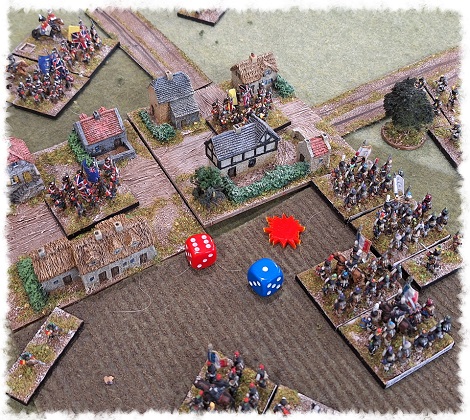
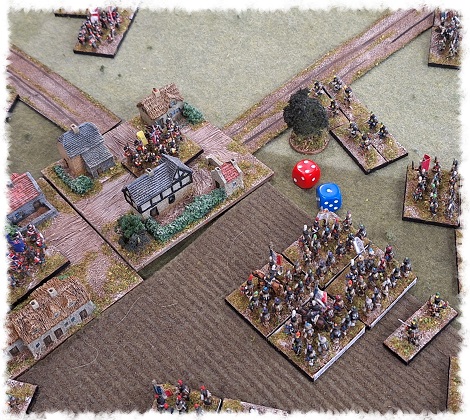
Below: Bachelu’s two brigades get hit by some accurate artillery fire as they advance down into the valley. His formations start to fall apart as some battalions slow their pace under the weight of fire.

Artillery: When left to their own devices fire in one of two ways, bombardment or canister. They can also offer close support fire and engage in counter-battery fire but must be ordered to do so by their divisional commander (for 1 command point).
Pictured left is Bachelu’s division which has come under fire from the Dutch/Belgian artillery deployed on the ridge line. An artillery bombardment targets the brigade as a whole rather than any unit within the brigade. Both players roll 1D6, add factors and compare the result. If the battery rolls lower it has missed and nothing happens. If it beats but doesn’t double its target the brigade takes 1DDP. However, if it doubles the target’s score the brigade takes 2DDP and one of its units is forced to give ground.
In OtG battalions or cavalry regiments grouped into formations can move as one for a single command pip. A heavy bombardment can break these formations apart thereby making them much more costly (in command point terms) to move about the battlefield.
French turn 3:

This was a big turn for the French. Jerome commits both brigades to the attacks on the village. Launching no less than three assault columns into the two BUA sectors. His skirmishers slowly gain the upper hand in the woods.
Kempt’s British brigade in the centre has suffered badly (4DDPs) from the grand battery on the French ridge line. Foy pushes his brigades forward to hit the British before they can rally. In the field below the walled farm, some British skirmishers have made a stand behind the hedge line. This has succeeded in disrupting Jamin’s columns.
Pire’s Lancers ran down some wayward skirmishers last turn. Now Huber’s Châsseurs want a piece of the action. They charge up the hill and hit the 2nd battalion of the 28th Nassau. Gronnier’s horse battery unlimbers and fires in support of the charging horsemen.
Despite growing disorder amongst his ranks, Bachelu pushes his division forward. It seems to me that he has forgotten his role in the French plan.

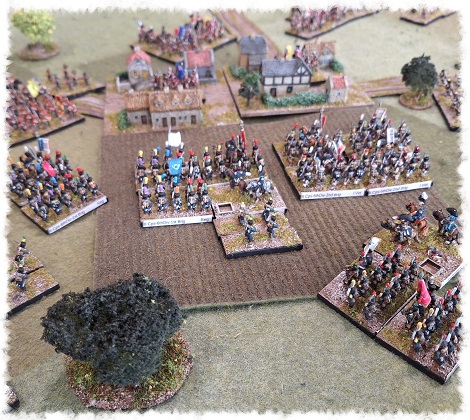
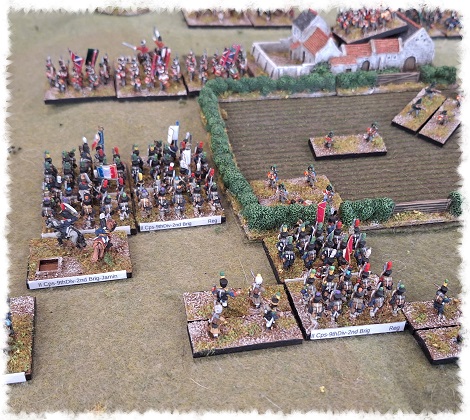

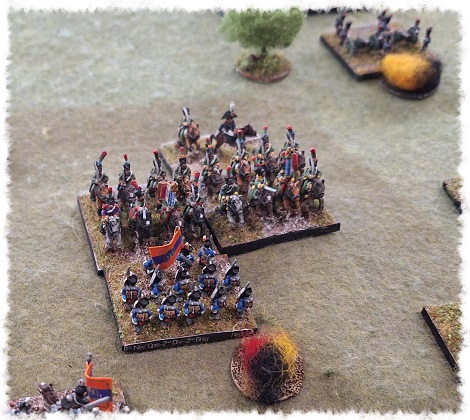
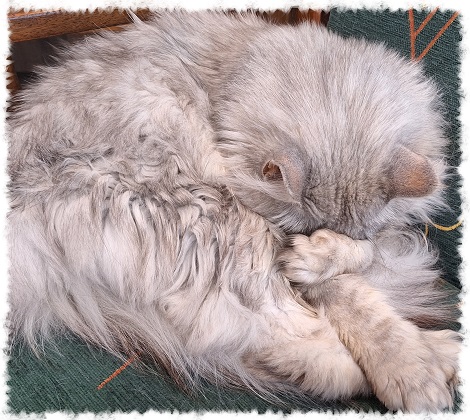
The charge of the 1st and 6th Châsseurs:
Troop formations in this system are inferred by an element’s actions and their army doctrine. Although a big part of Napoleonic gaming for me is seeing the battalions on the table in square, column or line formation. For games of this size, it’s just not practical.
In the case of the cavalry charge above the combat played out as follows.
- French regular light cavalry regiment (4) Artillery support(+1) 1D6(+3)=8
- Nassau regular (inferior) line battalion (3) Higher ground(+1) Overlapped(-1) 1D6(+2)=5
- The infantry battalion was beaten, but not doubled so has formed a square and compelled the horsemen to retire.
The Nassau brigade add 1DDP for losing the combat and the French cavalry also gained 1DDP as the brigade engaged in melee this turn.

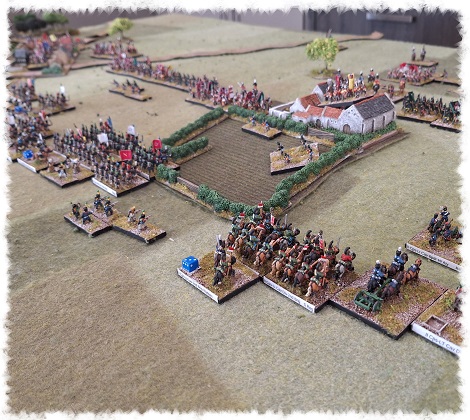
At the close of turn three both armies had lost six skirmish stands each. Most Brigades are now carrying various amounts of disorder points. Picton’s formation has suffered the most at this stage. Two of his brigades (pictured above) currently hold two and three DDPs each. However, Kempt’s brigade on the left (just out of shot) holds six DDPs. This drops his brigade one morale level from firm to Nervous (-1 to all combats). Unfortunately, he will have to soak up another round of French artillery fire before he can try to rally his troops.
I think that’s about enough for now. I hope you enjoyed this little look into my ongoing rule project. Next time I hope to cover turns 4 to 6 and take a look at how the chain of command has a major bearing on the rules.
